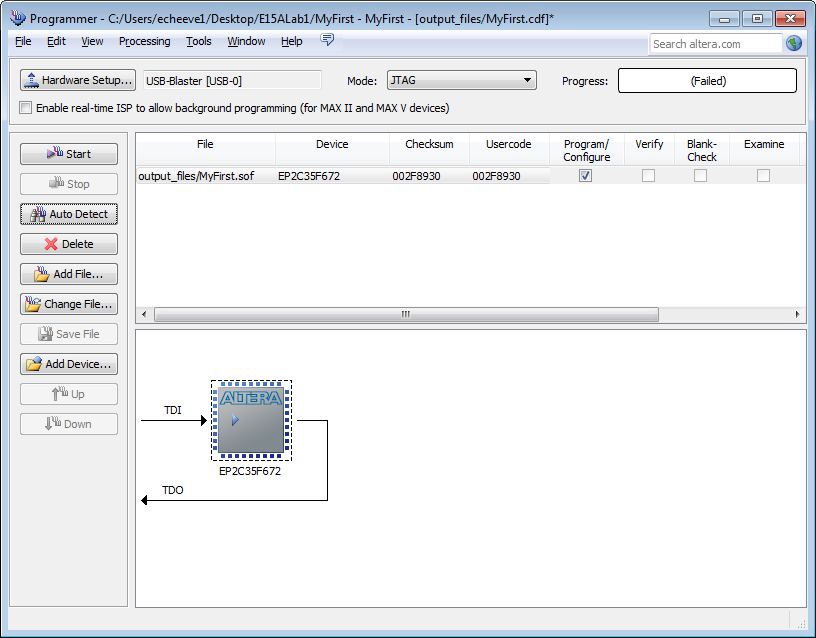

- Altera quartus ii programmer detect usb blaster software#
- Altera quartus ii programmer detect usb blaster Pc#
- Altera quartus ii programmer detect usb blaster license#
- Altera quartus ii programmer detect usb blaster download#
The demo software for the POWERLINK evaluation boards is located in the hardware/boards/terasic-de2-115 directory of your POWERLINK Slave release. This section describes the generation of the FPGA bitstream by using the Altera toolchain. When using a design with 16 bit parallel interface, the following pins on header JP5 (16 bit parallel pins at INK board GPIO header JP5) are used for externally connecting the application processor. The boards can be connected with the active JP5 header pins one by one. This is particularly useful if you have two TERASIC DE2-115 boards available. Implements an example host ready for connection to ink_pcp_16bitprll. The data exchange between host and PCP is done over a shared memory. Implements a PCP design with a 16 bit (data width) parallel interface. There are two hardware examples available in the /hardware/boards/terasic-de2-115 The application outputs are mapped to object number 0圆200 with subindex 0x01. Note The application inputs are mapped to object number 0圆000 with subindex 0x01. Settings for POWERLINK CN example designs on the INK Board. Do not connect Vcc signals between different boards, but connect the GND pins to ensure a common ground level. The I/O standard for all involved pins is 3.3 V. Note In field applications CAT 5e cables are required. Switch on the board with the power button (SW 18).Set the POWERLINK Node ID to '1': Push SW 10 to upper position.Connect one Ethernet port of the INK-board to a POWERLINK MN.
Altera quartus ii programmer detect usb blaster Pc#
Altera quartus ii programmer detect usb blaster download#
This chapter explains how this board needs to be configured and connected to the network.įor general information download the user guide for the board from the TERASIC Website. In order to get a POWERLINK slave up and running the TERASIC DE2-115 has to be set up. Hardware setup of the TERASIC DE2-115 (INK) board

Experience with this development environment is required.
Altera quartus ii programmer detect usb blaster license#
Other than for your final product, no Nios II IP-Core license is needed for evaluating the supplied example designs. This license is required for compiling the PCP FPGA configuration with Quartus II (generation of an *.sof file). Note Contact your local Altera distributor in order to acquire a Nios II IP-Core license. Altera Quartus II v13.0 SP1 (Web Edition is also possible).Development Board TERASIC_DE2-115 (INK Board).Process data: 4 bytes input and 4 bytes output.The software project for the host can be found in apps: Note Hardware designs can be ported easily to other platforms by reusing the Qsys subsystem instances in hardware/ipcore/altera/qsys/cn_pcp! hardware/boards/terasic-de2-115/cn-single-hostif-gpio.hardware/boards/terasic-de2-115/cn-single-hostif-drv.hardware/boards/terasic-de2-115/cn-dual-hostif-gpio.The host is implemented as a second internal Nios II processor or a external Nios II on a second TERASIC DE2-115 board. The processor running the device's main application is called host. hardware/boards/terasic-de2-115/cn-single-gpioĭual processor GPIO demos: Both processors are interconnected by an parallel interface.The following CN Quartus projects are available for the TERASIC DE2-115 INK board:

Additionally, a hub IP-Core is provided enabling daisy chained networks. The Ethernet interface is built with the POWERLINK-optimized controller openMAC, which enables e.g. The CN implementation applies the soft-core processor Altera Nios II to execute the protocol stack. The POWERLINK CN on Altera FPGA implementation utilizes IP-Cores available in Altera Qsys and provided with the openPOWERLINK stack in the directory hardware/ipcore.


 0 kommentar(er)
0 kommentar(er)
